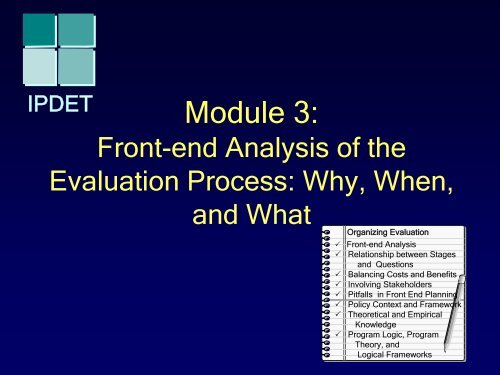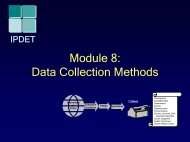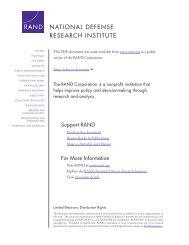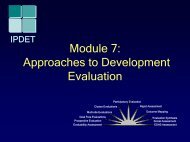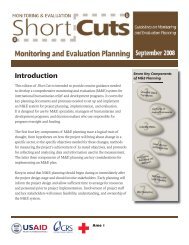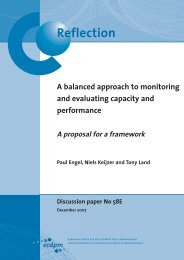Module 3:
Module 3:
Module 3:
Create successful ePaper yourself
Turn your PDF publications into a flip-book with our unique Google optimized e-Paper software.
IPDET<br />
<strong>Module</strong> 3:<br />
Front-end Analysis of the<br />
Evaluation Process: Why, When,<br />
and What<br />
<br />
<br />
<br />
<br />
<br />
<br />
<br />
<br />
Organizing Evaluation<br />
Front-end Analysis<br />
Relationship between Stages<br />
and Questions<br />
Balancing Costs and Benefits<br />
Involving Stakeholders<br />
Pitfalls in Front End Planning<br />
Policy Context and Framework<br />
Theoretical and Empirical<br />
Knowledge<br />
Program Logic, Program<br />
Theory, and<br />
Logical Frameworks
Introduction<br />
• Front-end Analysis of the Project, Program, or<br />
Policy<br />
• Balancing Costs and Benefits and Pitfalls of<br />
Evaluation<br />
• Involving Stakeholders<br />
• Policy Context and Its Framework<br />
• Existing Theoretical and Empirical Knowledge<br />
about the Project, Program, or Policy<br />
• Program Logic, Program Theory, and Logical<br />
Frameworks<br />
IPDET 2 2
Front-End Analysis<br />
• Pay attention to:<br />
– timing and time management<br />
– selection of actors and resources involved<br />
in the evaluation<br />
– design of the study<br />
– role of program logic and program theory<br />
– question to what extent data that are<br />
needed can be made available<br />
IPDET 3 3
Costs of the Evaluation<br />
• Evaluations are limited by time and money,<br />
some more than others<br />
• Examples of costs:<br />
– cost of evaluation in relation to the cost of the<br />
program<br />
– costs in terms of the social burden to program<br />
officials, evaluands, respondents<br />
– reputation costs to the evaluator and the<br />
evaluation community<br />
– transaction costs<br />
IPDET 4 4
Benefits of Evaluation<br />
• Examples of benefits:<br />
– strong knowledge<br />
– clear understanding<br />
– context specification of what will work<br />
– answers to questions<br />
IPDET 5 5
Dangers or Pitfalls<br />
• The belief that everything should be covered<br />
up front<br />
• The to-do-ism fixation<br />
• McDonaldisation of society<br />
• Truisms pop up while doing the front-end<br />
planning<br />
• Front-end planning does not prevent people to<br />
join in “group think”<br />
• Power matters, never forget to look at the<br />
power position of the participants<br />
IPDET 6 6
Stakeholders<br />
• People or representatives of<br />
organizations that have a “stake” in the<br />
intervention<br />
• Those affected by an intervention, in its<br />
lifetime, or in subsequent years<br />
• Important to include those who would<br />
typically not be asked to participate<br />
IPDET 7 7
Examples of Stakeholders<br />
• Participants<br />
• Direct beneficiaries<br />
• Indirect beneficiaries<br />
• Others impacted (directly or indirectly)<br />
• Donors<br />
• Government officials<br />
• Program directors<br />
• Policy-makers<br />
• Community and interest groups or associations<br />
IPDET 8 8
Stakeholder Roles<br />
• Each evaluation is different,<br />
stakeholders have different roles<br />
• Use a checklist to determine the role(s)<br />
of each stakeholder (example on next<br />
slide)<br />
IPDET 9 9
Checklist of Stakeholder<br />
Roles<br />
Individuals, groups,<br />
or agencies<br />
To<br />
make<br />
policy<br />
To make<br />
operational<br />
decisions<br />
To provide<br />
input to<br />
evaluation<br />
To<br />
react<br />
For<br />
interest<br />
only<br />
Developer of<br />
program<br />
Funder of program<br />
Boards/agencies<br />
etc.<br />
IPDET 10 10
Involving Stakeholders<br />
• Identify the stakeholders<br />
• Have periodic stakeholder meetings<br />
• Involve early on so all have understanding of the<br />
intervention<br />
• Value:<br />
– generate better questions<br />
– generate support for the evaluation<br />
– increase access to whatever information is available<br />
– enhance the acceptance of the final report and<br />
recommendations<br />
IPDET 11 11
Stakeholder Analysis<br />
• A technique to identify and assess the<br />
importance of key people, groups of people or<br />
institutions<br />
• Reasons to do:<br />
– identify people, groups, and institutions<br />
– anticipate the kind of influence – positive or<br />
negative – these groups will have on your initiative<br />
– develop strategies to get the most effective<br />
support possible<br />
IPDET 12 12
Stakeholder Analysis<br />
“How To” and Example<br />
Stakeholder<br />
Stakeholder<br />
Interest(s) in the<br />
Project<br />
Assessment<br />
of Impact<br />
Potential Strategies<br />
for Obtaining<br />
Support or Reducing<br />
Obstacles<br />
IPDET 13 13
World Bank on Involving<br />
Stakeholders<br />
• Building trust<br />
• Involving directly affected stakeholders<br />
• Involving the voiceless<br />
• Involving the opposition<br />
• (more information in print materials)<br />
IPDET 14 14
Consumers (Impactees)<br />
• Recipients/ users of the services or<br />
products<br />
• Downstream, indirect impactees<br />
• Program staff<br />
• Funding agency, taxpayers, and political<br />
supporters, called upstream impactees<br />
IPDET 15 15
Stage of program<br />
development<br />
Assessment of social problem<br />
and needs<br />
Determination of goals<br />
Design of program<br />
alternatives<br />
Selection of alternative<br />
Program implementation<br />
Program operation<br />
Program<br />
outcomes/effects/impact<br />
Program efficiency<br />
Program Stages and the Broad<br />
Evaluation Question<br />
Evaluation question to be asked<br />
To what extent are community needs and standards met?<br />
What must be done to meet those needs and standards?<br />
What services could be used to produce the desired<br />
changes?<br />
Which of the possible program approaches is most robust?<br />
How should the program be put into operation?<br />
Is the program operating as planned?<br />
Is the program having the desired effects?<br />
Are the program effects attainted at a reasonable cost?<br />
IPDET 16 16
Focus on Policy Context<br />
• The underlying program theory<br />
• Using existing evidence through<br />
research synthesis<br />
• Interpreting a complex program as<br />
intervention chains:<br />
– one set of stakeholders provide resources<br />
to other stakeholders<br />
– belief that behavior change will follow<br />
IPDET 17 17
Theoretical and Empirical<br />
Knowledge<br />
• Sources:<br />
– Journals synthesizing the accumulation of<br />
explanatory knowledge<br />
– evaluations and other social science<br />
research, including psychological and<br />
economic studies<br />
– problem-based research<br />
– repositories of randomized experiments<br />
• Knowledge Fund<br />
IPDET 18 18
Articulating the Theory of Change<br />
• Map out how the program is supposed to<br />
work<br />
• When and how underlying logic and theory<br />
will be reconstructed and tested<br />
• Four types of logical framework analysis:<br />
– program theory<br />
– logic models<br />
– program outcome model<br />
– logical framework (logframe)<br />
IPDET 19 19
Advantages<br />
• Ensures that decision makers ask<br />
fundamental questions and analyze<br />
assumptions and risks<br />
• Engages stakeholders in the planning and<br />
monitoring process<br />
• When used dynamically, it is an effective<br />
management tool to guide implementation,<br />
monitoring, and evaluation<br />
IPDET 20 20
Review or Create<br />
• If the program/project already has a<br />
developed theory of change, carefully<br />
review it<br />
– may need to refine or rework it<br />
• If there is no theory of change, need to<br />
create one<br />
IPDET 21 21
Program Theory<br />
• A type of program description that<br />
includes:<br />
– normative theory (programs as they should be)<br />
– theories of people involved with the program<br />
– causative models (links problem to program)<br />
– research theory<br />
• Can provide clues to appropriate<br />
evaluation questions<br />
IPDET 22 22
Frameworks for Assessing<br />
Program Theory<br />
• Assessment in relation to social needs<br />
• Assessment of logic and plausibility<br />
• Assessment through comparison with<br />
research and practice<br />
• Assessment by confronting a program<br />
theory with one or more relevant<br />
scientific theories<br />
• Assessment via preliminary observation<br />
IPDET 23 23
How “Theories” Work<br />
• Note the research that explains or<br />
predicts an event<br />
– example: students do better when parents<br />
are involved in their studies<br />
• The program theory links what the<br />
research is showing to a “theory” of the<br />
effects of the project/program<br />
IPDET 24 24
Theories of Change Models should<br />
Answer these Questions:<br />
• Are all elements well defined?<br />
• Are there any gaps in the logical chain<br />
of events?<br />
• Are relationships plausible and<br />
consistent?<br />
• Is it realistic to assume that the program<br />
will result in the attainment of stated<br />
goals in a meaningful manner?<br />
IPDET 25 25
Advantages/Disadvantages<br />
of Program Theory Model<br />
• Effective tool to illustrate the<br />
interdependent relationships among the<br />
activities and goals of the program<br />
• Weakness comes because it does not<br />
show the inter-relationships and factors<br />
in the external environment<br />
that might influence outcomes<br />
IPDET 26 26
Example of Program<br />
Theory Model<br />
Visits by teachers to students’ homes<br />
Sharing of views by parent and teacher<br />
Teachers’<br />
understanding of<br />
the home culture<br />
Parents’ knowledge<br />
of school’s<br />
expectations for<br />
students<br />
Identification of<br />
special problems that<br />
retard student’s<br />
achievement (health,<br />
emotional, etc.)<br />
Teachers’<br />
sympathy with<br />
children and their<br />
view of the world<br />
Parental support and<br />
encouragement with<br />
child’s homework and<br />
school assignments<br />
Parental support<br />
for better<br />
attendance at<br />
school<br />
Parents’ knowledge<br />
of school’s<br />
expectations for<br />
students<br />
Teaching in terms<br />
comfortable and<br />
understandable to<br />
students<br />
Conscientiousness<br />
of work by students<br />
Student attendance<br />
Student’s receipt of<br />
special help<br />
Student moral<br />
Improvement of<br />
condition (health,<br />
emotional)<br />
Achievement in reading<br />
IPDET 27 27
Logic Models<br />
• Useful ways to understand the link<br />
between a program and its expected<br />
outcomes<br />
• In a sense, development interventions<br />
are theories<br />
– by doing A, we should get X to happen<br />
– sometimes a chain of relationships<br />
IPDET 28 28
Simple Logic Model<br />
Training Training<br />
High High Quality Quality<br />
Evaluations Evaluations<br />
Useful Useful<br />
Information Information<br />
Better Better<br />
Decisions Decisions<br />
By training<br />
We should get<br />
better decisions<br />
IPDET 29 29
Logic Model<br />
Characteristics<br />
• Most are not linear<br />
• Usually have boxes and/or arrows that<br />
link back to earlier or ahead to later<br />
parts of the model<br />
• Can move vertical, horizontally,<br />
circularly, or a storyboard<br />
IPDET 30 30
Advantages of Logic<br />
Models<br />
• Provides a common language<br />
• Helps differentiate between “what we do” and<br />
“results” – outcomes<br />
• Increases understanding about the program<br />
• Leads to improved planning and management<br />
• Increases intentionality and purpose<br />
• Provides coherence across complex tasks,<br />
diverse environments<br />
(cont.)<br />
IPDET 31 31
Advantages of Logic<br />
Models (cont.)<br />
• Enhances team work<br />
• Guides prioritization and allocation of<br />
resources<br />
• Motivates staff<br />
• Helps identify important variables to<br />
measure, use resources, opportunities,<br />
recognition<br />
IPDET 32 32
Benefits and Cautions of<br />
Logic Models<br />
• Help identify elements of programs that are<br />
critical to success<br />
• Help provide a common understanding of the<br />
program and expectations among<br />
stakeholders based on a common language<br />
• Provide a foundation for evaluations<br />
• Poorly specified models limit the ability to<br />
identify and subsequently measure<br />
intervening variables on which outcomes<br />
depend<br />
IPDET 33 33
Logic Model for a<br />
Micro-Lending Program<br />
Access to start-up<br />
funds for small<br />
businesses<br />
Income and<br />
employment for<br />
local people<br />
Improved living<br />
conditions<br />
Financial management<br />
advice and support<br />
Skills in business<br />
& financial<br />
management<br />
Reduced family<br />
poverty<br />
IPDET 34 34
Women have limited access to economic<br />
opportunities due to lack of access to credit and<br />
other productive resources and to social control<br />
Project offers credit,<br />
technical assistance and<br />
group information<br />
Women create<br />
business<br />
Generate profits<br />
Short-term improvement<br />
in household welfare<br />
Profits re-invested<br />
Permanent improvement<br />
in household welfare<br />
Business<br />
sustained<br />
Impact nutrition,<br />
health, and<br />
clothing<br />
Improved<br />
housing<br />
Improved<br />
education for<br />
girls<br />
Economic<br />
improvements<br />
IPDET 35 35
Program Outcome Model<br />
• Model portrayed using:<br />
– inputs: resources put into program<br />
– activities: what the program does<br />
– outputs:services or products produced<br />
– outcomes: effect or result of the activities<br />
and outputs<br />
– impacts: longer term consequences of the<br />
program<br />
IPDET 36 36
Example of Program<br />
Outcome Model<br />
Inputs<br />
<br />
Activities Activities Outputs Outcomes Impacts<br />
Outcomes<br />
Resources<br />
▪ Money<br />
▪ Staff<br />
▪ Volunteers<br />
▪ Supplies<br />
Services<br />
▪ Training<br />
▪ Education<br />
▪ Counselling<br />
Products<br />
▪ Total # of<br />
classes<br />
▪ Hours of service<br />
▪ Number of<br />
participants<br />
completing<br />
course<br />
Benefits<br />
▪ New knowledge<br />
▪ Increased skills<br />
▪ Changed<br />
attitudes<br />
▪ New<br />
employment<br />
opportunities<br />
Changes<br />
▪ Trainers earn<br />
more over five<br />
years than those<br />
not receiving<br />
training<br />
▪ Trainees have<br />
higher standard<br />
of living than the<br />
control group<br />
IPDET 37 37
Logical Framework<br />
(Logframe)<br />
• Links the activities, results, purpose, and<br />
objectives of an intervention<br />
• Is a specific logic model using a 4 x 4 matrix<br />
• For each component, the evaluator identifies<br />
the:<br />
– indicators that are needed<br />
– sources<br />
– assumptions<br />
IPDET 38 38
Example of Logframe<br />
Narrative<br />
Summary<br />
Performance<br />
Indicators<br />
M&E/Supervision/<br />
Verification<br />
Key<br />
Assumptions<br />
Program Goal:<br />
Project<br />
Development<br />
Objective:<br />
Outputs:<br />
Components:<br />
IPDET 39 39
Advantages and Limitations<br />
in Using Logframes<br />
Advantages<br />
• Ensures decisionmakers<br />
ask<br />
fundamental questions<br />
and analyze<br />
assumptions and risks<br />
• Engages stakeholders<br />
• Can be an effective<br />
management tool<br />
Limitations<br />
• Limiting tool because of<br />
focus on intended effects<br />
• An assumption of<br />
consensual project objects<br />
can be problematic<br />
• Automatic choice of an<br />
audit form of accountability<br />
as the priority<br />
IPDET 40 40
To continue on to the<br />
Next <strong>Module</strong> click here<br />
To return to the<br />
Table of Contents click here


